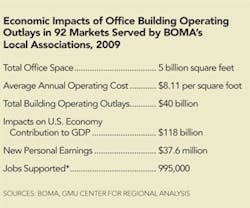The Economics of Buildings
What happens to the economy of the area surrounding an office building when no one comes to work?
The value of an office building starts at development and construction; however, the economic impacts during this phase are limited. After occupancy, an office building becomes a powerful economic engine with benefits that last over its lifetime.
To quantify this, BOMA commissioned an independent study to analyze the private office sector’s economic impact in the 92 markets where BOMA local associations are located. While the study focused on commercial office buildings over 10,000 square feet and excluded owner-occupied and government buildings, its findings clearly show the important role the commercial real estate industry plays in the economy.
Supporting Local Business
In 2009, the 5 billion square feet of office space quantified in the study generated $40 billion in annual expenditures. This spending supported local employment and business activities directly associated with these buildings in management, repairs and maintenance, building services, and utilities. Additionally, payroll dollars within the local and state economies were re-spent for consumer goods and services while non-payroll expenditures ultimately supported additional payroll and business spending. The $40 billion in direct office building operating expenditures contributed $118.4 billion to the U.S. economy in 2009. Simply put, for each $1 of office building spending, on average, $2.90 was put back into the U.S. economy.
As these office building operating expenditures funnel down into the economy, they generate new personal earnings for workers whose cities then benefit from the increased business. Last year, our industry generated $37.6 billion in new personal earnings as a result of the jobs supported directly by its spending and those jobs supported by the re-spending of these dollars for consumer goods and services. These new personal earnings directly expand the tax bases in local and state jurisdictions served by BOMA local associations. Nationally, for each $1 in direct spending, 92 cents of new personal earnings were generated.
Supporting Jobs
The impact on jobs is even more significant when you view it from a national perspective. Annual office building spending in BOMA’s 92 markets supports a workforce that exceeds 1 million workers (20 to 25 full-time equivalent jobs per 100,000 gross square feet of office space). The direct and indirect spending associated with our industry supports an additional 995,000 jobs across local and state economies. Our industry also provides workspace for an estimated 21 million office jobs whose productivity is enhanced by the building and management services we provide.
Expenditures for building management, maintenance and repair, building services, and utilities recur annually and increase as that inventory grows. These expenditures support local business that provide contract building services, and then generate jobs for a wide range of services. The workers housed in an office building also have an impact on the local economy. These workers support public transportation and restaurants, which has a ripple effect, creating more jobs.
Strength in Good and Bad Times
Office-sector jobs hold a strong market share of the overall job pool, which adds to the impact of buildings. According to the report, annual spending is a function of the inventory of office space that continues to grow in dynamic markets in response to the economy’s shift away from goods-producing jobs to services-producing jobs, and also grows with the economy’s general expansion. Even in a slowing economy or during recessions, expenditures associated with office building operations aren’t as cyclically sensitive as other segments, such as manufacturing, construction, and retail trade. As these expenditures cycle through the local, state, and national economies, they generate additional economic activity, support significant direct and indirect job growth, and generate new personal earnings that provide further stimulus.
As this study shows, commercial real estate is a significant contributor to the local, state, and U.S. economies. From the Great Depression to the Great Recession, our industry has a history of weathering downturns. We will continue to be the place where America goes to work.
James A. Peck is chair and chief elected officer of BOMA International and senior director of asset services at CB Richard Ellis in Albuquerque, NM. He can be reached at [email protected].
